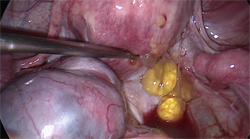Dr. Sankar Dasmahapatra
Endometriosis Specialist in Kolkata, India
DGO, MS, Fellowship in Gynaecological Lap Surgery (Sydney -Australia)
Consultant Gynaecologist & Obstetrician
Infertility Specialist & Lapaoscopic Surgeon
DGO, MS, Fellowship in Gynaecological Lap Surgery (Sydney -Australia)
Consultant Gynaecologist & Obstetrician
Infertility Specialist & Lapaoscopic Surgeon
Endometriosis is a condition where tissue similar to the lining of the uterus (which should only be located inside the uterus) is found elsewhere in the body.
Endometriosis lesions can be found anywhere in the pelvic cavity: on the ovaries, the fallopian tubes, and on the pelvic sidewall. Other common sites include the uterosacral ligaments, the cul-de-sac, the pouch of Douglas, and in the recto-vaginal septum.
In addition, it can be found in caesarian-section scars, laparoscopy or laparotomy scars, and on the bladder, bowel, intestines, colon, appendix, and rectum.
The most common symptom of endometriosis is pelvic pain. The pain often correlates to the menstrual cycle, but a woman with endometriosis may also experience pain that doesn’t correlate to her cycle. For many women, the pain of endometriosis is so severe and debilitating that it impacts their lives in significant ways.
Endometriosis can also cause scar tissue and adhesions to develop that can distort a woman’s internal anatomy. In advanced stages, internal organs may fuse together, causing a condition known as a "Frozen Pelvis."
It is estimated that 30-40% of women with endometriosis are infertile.

Symptoms of endometriosis
The most common symptom of endometriosis is pelvic pain. The pain often correlates to the menstrual cycle, however a woman with endometriosis may also experience pain at other times during her monthly cycle.
For many women, but not everyone, the pain of endometriosis can unfortunately be so severe and debilitating that it impacts on her life significant ways.
Pain may be felt
• before/during/after menstruation
• during ovulation
• in the bowel during menstruation
• when passing urine
• during or after sexual intercourse
• in the lower back region
Other symptoms may include
diarrhoea or constipation (in particular in connection with menstruation)
• abdominal bloating (again, in connection with menstruation)
• heavy or irregular bleeding
• fatigue
• The other well known symptom associated with endometriosis is infertility. It is estimated that 30-40% of women with endometriosis are sub fertile.
What causes endometriosis?
Several different hypotheses have been put forward as to what causes endometriosis. Unfortunately, none of these theories have ever been entirely proven, nor do they fully explain all the mechanisms associated with the development of the disease. Thus, the cause of endometriosis remains unknown.
Diagnosing endometriosis
There is no simple test that can be used to diagnose endometriosis. In fact, the only reliable way to definitively diagnose endometriosis is by performing a laparoscopy and to take a biopsy of the tissue. This is what is known as "the gold standard".
However, this is an expensive, invasive procedure. Furthermore, if the surgeon is not a specialist in endometriosis she may not recognise the disease, which can result in a "negative" diagnosis.
In addition, the woman/girl may not want to have surgery.
This makes diagnosis a challenge, and therefore an experienced gynaecologist should be able to recognize symptoms suggestive of endometriosis through talking with the woman/girl and obtain a history of her symptoms. For this to be effective, it is important that the woman/girl is honest with her physician about all of her symptoms and the pattern of these.
There are other tests, which the gynaecologist may perform. These include ultrasound, MRI scans, and gynaecological examinations. None of these can definitively confirm endometriosis (though they can be suggestive of the disease), nor can they definitively dismiss the presence of endometriotic lesions/cysts.
The fact that there is no non-invasive, definitive diagnostic method for endometriosis is as frustrating for clinicians as it is for women with the disease.
Treatments for endometriosis
Since the cause of endometriosis remains unknown, a treatment which fully cures endometriosis has yet to be developed.
Choosing a treatment therefore comes down to the individual woman's wishes, depending on her symptoms, her age, and her fertility wishes. She should discuss these with her physician so that they, together, can determine which long term, holistic, treatment plan is best for her individual needs. For many women, this can be a combination of more than one treatment.
1) Pain Killers
2) Hormonal therapy may include birth control pills, progestins, a class of drugs known as GnRH-analogues, and danazol.
3) Surgery Most doctors agree that laparoscopic surgery is the only definitive way to diagnose endometriosis. In many cases, the disease can be diagnosed and treated in the same procedure. The success of surgery depends greatly on the skill of the surgeon and the thoroughness of the surgery. The aim is to remove all endometriosis lesions, cysts, and adhesions. Today, most endometriosis surgery is being done through the laparoscope, although a full abdominal incision called a laparotomy may still be required in rare cases for extensive disease or bowel resections.